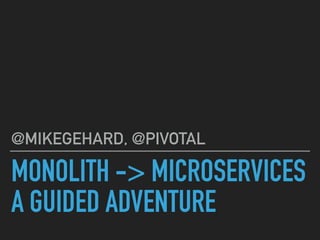
The Journey from Monolith to Microservices: a Guided Adventure
- 1. MONOLITH -> MICROSERVICES A GUIDED ADVENTURE @MIKEGEHARD, @PIVOTAL
- 2. ABOUT ME ▸ Working with clients to migrate legacy monoliths -> microservices ▸ Worked on the Spring Cloud Services team ▸ Trying not to be a Chief Principal Senior Consultant Scientist
- 3. ABOUT YOU ▸ Have a monolith that needs migrating? ▸ Actively migrating a monolith? ▸ Building microservices net new? ▸ This talk has a little bit for all of you…
- 4. AGENDA ▸ Where did these ideas come from? ▸ Which comes first? ▸ What is the path?
- 5. BACKGROUND
- 11. THIS SHOULD NOT BE REVOLUTIONARY
- 15. IT DEPENDS…
- 17. MODULAR MONOLITH
- 18. IF YOU CAN’T BUILD A WELL STRUCTURED MONOLITH, WHAT MAKES YOU THINK YOU CAN BUILD A WELL STRUCTURED SET OF MICROSERVICES? UNKNOWN TEXT
- 20. BOUNDARIES?
- 21. BOUNDED CONTEXTS
- 22. 2003 2013
- 23. SOUND FAMILAR?
- 24. HOW DO I GET THERE?
- 26. GOALS ▸ Migrate a monolith that was in production, making money, to a more sustainable solution for the future. ▸ Architect for scalability of app in the future. ▸ Allow multiple teams to deliver business value quickly. ▸ Allow for addition of resources without overcrowding.
- 27. CURRENT STATE ▸ API servers ▸ Multiple clients, including JavaScript front end ▸ Some dead code ▸ Lack of comprehensive, current API tests
- 32. GOAL: VALIDATE YOU DON'T BREAK ANY CLIENT FACING BEHAVIOR WHILE MIGRATING STEP 1: API LEVEL TESTS
- 34. DESIRED END STATE CLIENT CLIENT CLIENT CLIENT OLD API OLD API OLD APIOLD API
- 38. RESULT: YOU NOW KNOW WHEN YOU HAVE BROKEN USER FACING BEHAVIOR BEFORE YOU GO INTO PRODUCTION
- 39. GOAL: BEGIN TO UNDERSTAND WHAT BOUNDED CONTEXTS EXIST STEP 2: ARRANGE APPLICATION SO YOU CAN SEE YOUR DOMAIN
- 42. STEP 2: ARRANGE APPLICATION SO YOU CAN SEE YOUR DOMAIN ▸ Minimizes the number of directories where changes happen. ▸ Less costly to experiment with/evolve bounded contexts. ▸ Delaying architecture decisions.
- 43. GOAL: GIVE MORE SPACE IN THE CODEBASE AND SOLIDIFY DEPENDENCIES/BOUNDARIES. STEP 3: BREAK OUT COMPONENTS
- 46. WHAT ABOUT DATABASES? ▸ Application manages? ▸ Component manages? ▸ “It depends…”
- 47. RULE: MIGRATIONS ONLY TOUCH ONE TABLE.
- 48. WHY?
- 49. STEP 3: BREAK OUT COMPONENTS ▸ More room in the codebase for multiple teams. ▸ Strict boundaries between framework code and domain code. ▸ Moving closer to microservices without the overhead of multiple processes. ▸ Stopping here gives you a lot of benefits without overhead of microservices.
- 50. GOAL: IT DEPENDS… STEP 4: PROMOTE YOUR FIRST MICROSERVICE
- 51. WHY EXTRACT A MICROSERVICE? ▸ Scaling a certain bounded context becomes an issue. ▸ You want to deploy one bounded context more frequently. ▸ Many, many other reasons that I won’t cover here.
- 53. WHY NOT EXTRACT A MICROSERVICE? ▸ Cost of managing the service outweighs the benefits. ▸ Dysfunctional communication patterns in the org ▸ Many, many other reasons that I won’t cover here.
- 54. BILLING EMAIL
- 55. BILLING EMAIL
- 56. STEP 4: EXTRACT YOUR FIRST MICRO SERVICE ▸ Congratulations you now have a distributed system!!! ▸ And with that distributed system come new costs: ▸ Billing now needs to know how to contact the email service. ▸ Network communication between billing and email will fail at some point.
- 57. GOAL: ABSTRACT LOCATION AND QUANTITY OF SERVICE INSTANCES SERVICE DISCOVERY
- 59. SERVICE DISCOVERY ▸ Service calls are most loosely coupled to location and number of instances. ▸ Client side load balancing can reduce number of network calls. ▸ But there is an additional applications to run and monitor.
- 60. GOAL: PROTECT AGAINST CASCADING FAILURES THAT CAUSE SYSTEM DOWNTIME CIRCUIT BREAKER
- 63. CIRCUIT BREAKERS ▸ Increased resiliency of system when the network or a service fails...because they will. ▸ Increased visibility of health of system as a whole. ▸ But there is an additional applications to run and monitor.
- 64. CONGRATULATIONS YOU ARE THE PROUD OWNER OF A SET OF MICROSERVICES!!
- 65. NEXT STEPS ▸ Break out more microservices as necessary. ▸ Change up the communication interface...maybe use a message queue? ▸ Don't do anything and continue to make money. ▸ The choice is up to you!
- 66. SOURCE CODE ▸ https://github.com/mikegehard/ journeyFromMonolithToMicroservices (Java) ▸ https://github.com/mikegehard/user-management- evolution-kotlin (Kotlin)
